Page 209 of 294

M N <( (.J
'SI: ,...., \!) 1.1'1
N \!) ,....,
Care and cleaning
Component Situation Solution
Paint
Paint damage Refer to the paint number on the vehicle data label, repair
with touch up paint
c> page 271
Spilled fuel Rinse with water immediately
Surface rust Rust remover, then protect with hard wax; for questions,
refer to an author ized Audi dealer.
Corrosion Ha
ve it removed by an authorized Audi dealer.
Water no longer Protect with hard wax (at least tw ice per year)
beads on the surface
of clean paint
No shine even though Treat with suitab le polish; then apply paint protectant if
paint has been pro- the polish that was used does not contain any protectant
tected/paint looks
poor
Deposits such as in- Dampen with water immediately and remove with a micro-
sects, bird droppings, fiber cloth
tree sap and road sa lt
Grease-based con-Remove immediately with a mild soap solutional and a soft
taminants such as cloth
cosmetics or sunb lock
Carbon parts Deposits clean the same way as painted parts c> page 205
al Mild soap solu tion: maximu m two ta ble spoon s of neu tral soap in 1 quart (1 lit er) of water
Internal cleaning
Component Situation Solution
Windows
Deposits Glass cleaner, then wipe dry
Decorative parts/ Deposits Mild soap so lutiona>
trim
Plastic parts
Deposits Damp cloth
Heavier deposits Mild soap solutiona>, detergent-free plastic clean ing solu-
tion, if necessary
Displays Deposits
Soft cloth with LCD cleaner
Controls Deposits Soft brush, then a soft clot h with a m ild soap solutional
Safety belts Deposits Mild soap solutiona>, allow to dry before letting them re-
tract
207
Page 210 of 294

Care and cleaning
Component S ituation Solution
Te xtiles
Deposits adhering to Vacuum cleaner
arti ficial leath er, the surface
Alca ntara Wate r-based depos its Absorben
t cloth and mild soap solutional
such as coffee, tea,
blood, etc.
Oil-based deposits Apply am ild soap solutional, blot away the disso lved oil or
such as oil, make-up, dye, treat afterwa rd with water, if necessary
etc.
Special deposits such Special stain remover, blot w ith absorbent materia l, treat
as ink, na il polish, la- afterward with mild soap so lution, if necessaryal
tex paint, shoe pol-
ish, etc.
Natural leather Fres h stains Wool cloth with a mild soap solut ional
Wate r-based depos its fresh stains: absorbent clot h
such as coffee, tea, d ried stains: stain remover suitable for leathe r
blood, etc.
Oil-based deposits Fresh stains: absorbent cloth and stain remover suitab le
such as oil, make- up, for leather
etc. dried stains: Oil cleaning spray
Special deposits such Spot remover sui table for leather
as ink, nai l polish, la -
tex paint, shoe pol-
ish, etc.
Care Regularly app ly condi tioning cream that protects from
lig ht and penet rates in to the mate rial. Use specially -col -
ored conditioning cream, if necessary.
Carbon part s Deposits clean the same way as plastic parts
al Mild soap sol ution: maxim um two tablespoons of neutral soap in 1 quar t (1 liter ) of water
_& WARNING
The windshie ld may not be tre ate d wit h wa
t er- repelling win dsh ield co ating agents. Un
favorab le conditions such as wetness, dark
ness, or low s un can resu lt in increased glare.
Wiper blade chatter is also possible.
(D Note
- Headlights/tail light s
-Never clean headlights or ta il lights with a
dry cloth or sponge.
- Do not use any cleaning prod uct that con
tains alcohol, because they could cause cracks to form.
- Wheels
208
-
- Never use any paint polish or other abra
sive mate rials.
- Damage to the protective layer on the
rims such as sto ne chips or sc ratches must
be repaired immediately.
- Sensors /camera lenses
- N eve r use warm or ho t w at er to remove
snow or ice from the camera lens . This
could ca use the lens to crack.
- N eve r use abras ive cle an ing m ateria ls or
a lcohol to clea n the camera lens. This
could ca use scratches and cracks .
-Doo r windows
- Remove snow and ice on windows and ex-
terio r mirro rs with a p lastic scraper. To
Page 211 of 294

M N <( (.J
'SI: ,...., \!) 1.1'1
N \!) ,....,
avoid scratches, move the scraper only in
one direction and not back and forth.
- Never remove snow or ice from door win
dows and mirrors using warm or hot water
because this could cause cracks to form.
- To avoid damage to the rear window de
fogger, do not apply any stickers on the
heating wires on the inside of the window.
- Decorative parts/trim
- Never use chrome care or cleaning prod-
ucts .
- Paint
- To reduce the risk of scratches, the vehicle
must be free of dirt and dust before pol
ishing or waxing.
- To prevent paint damage, do not polish or
wax the vehicle in direct sunlight.
- To reduce the risk of paint damage, do not
polish away rust spots.
- Remove cosmetics and sunscreen immedi
ately -these could damage the paint.
- Displays
- To avoid scratches, do not use dry cleaning
methods on displays.
- Controls
- Make sure that no fluids enter the con-
trols, because this could cause damage.
- Safety belts
- Do not remove the safety belts to clean
them.
- Never clean safety belts or their compo
nents chemically or with corrosive fluids
or solvents and never allow sharp objects
to come into contact with the safety belts.
This could cause damage to the belt web
bing.
- If there is damage to the webbing, the
connections, the retractors or the buckles,
have them replaced by an authorized deal
er.
- Textiles/artificial leather/Alcantara
- Never treat artificial leather/Alcantara
with leather care products, solvents, floor polish, shoe polish, spot remove or similar
products.
- Have a specialist remove stubborn stains
to prevent damage.
Care and cleaning
- Never use steam cleaners, brushes, hard
sponges, etc. when cleaning.
- Do not turn on the seat heating* to dry
the seat.
- Objects with sharp edges such as zippers,
rivets on clothing or belts can cause dam
age to the surface.
- Open hook and loop fasteners, for exam
ple on clothing, can damage seat covers.
Make sure hook and loop fasteners are
closed.
- Natural leather
- Never treat leather with solvents, floor
polish, shoe polish, spot remover or simi
lar products.
- Objects with sharp edges such as zippers, rivets on clothing or belts can cause dam
age to the surface .
- Never use steam cleaners, brushes, hard
sponges, etc. when cleaning .
- Do not turn on the seat heating* to dry the seat.
- To help prevent the leather from fading,
do not leave the vehicle in direct sunlight
for long periods of time. If leaving the ve
hicle parked for long periods of time, you
should cover the leather to protect it from
direct sunlight.
(D Tips
- Insects are easier to remove from paint that
has been freshly waxed .
- Regular waxing can prevent rust spots from
forming.
209
Page 212 of 294

Fuel and Refueling
Fuel and Refueling
Gasoline
Fuel supply
A pp lies to veh icles: w ith gaso line engine
Using the right fuel helps keep the environment
clean and prevents engine damage.
Fuel r eco mmendation
The f uel recommended for your vehicle is unlead
ed premium
grade gaso line. A udi recommends
using TOP TIER Detergent Gasoline with a min i
mum octane rating of 91 AKI (95 RON). For more
info rmation on TOP TIER Detergent Gasoli ne,
p lease go to the official website
(www.toptiergas.com).
The recommended gasoline octane rating for
your engine can a lso be found on a label located
on the ins ide of the fue l filler flap. This ra ting
may be specified as AKI or RON.
Your vehicle may also be operated using unlead
ed regula r gasol ine with a minimum octane rat
ing of 87 AKl/91 RON. However, using 87 AKl/91
RON octane fue l will slight ly reduce eng ine per
for mance.
Use unleaded ga soline only. Unleaded gasoline
is available th roughout the USA, Canada, and in
most European cou ntries. We recommend t hat
you do not ta ke yo ur vehicle to a reas or coun tries
where unlea ded gaso line may no t be ava ilab le.
For mo re info rmat ion on refueli ng your ve hicle,
see
¢page 212.
Octane rat ing
Octane rating ind icates a gaso line's ability to re
sist engine damaging "knock" caused by prema
ture ignition and detonation. The refore, buying
the co rrect g rade of gasoline is very importa nt to
he lp p revent possible eng ine damage a nd a loss
of eng ine pe rforma nce.
Gasoline most commonly used in the Un ited
States and Canada has the following octane rat
i n gs that ca n usually be found on the filler pump:
- Prem ium G rade: 91 - 96 AKI
210
- Regular Grade: 8 7 -90 AKI
E xplanation of the abb revia tions:
AKI = Anti Knock Index= (R+M)/2 = (RON+MON)/
2
RON= Research Octane Number
M ON= M otor Octane Number.
{[) Note
-Do not use a ny fue l w ith o ctane rat ings low
er th an 8 7 AKI or 91 R ON othe rwi se e xpe n
sive engine damage w ill occur .
- Do
not use le ade d gas oline . The u se of le ad
e d gasoline will severely damage your veh i
cle's cataly tic conver ter and i ts ab ility to
cont rol exha ust em issions.
Blended gasoline
App lies to vehicles: wit h gaso line e ngi ne
U se of g asoline cont aining alcohol or MTBE
(methyl tert iary butyl ether)
You may use unleaded gasoline blended with a l
cohol or MTBE (commonly referred to as oxygen
ates) if th e b le nded mixture mee ts the following
c riteria :
Blend of gasoline methanol (wood alcohol or
methyl alcohol)
- Anti -knoc k index must be 8 7 AKI or higher.
- Blend must contain no more t han 3% metha-
nol.
- Blend must contain more than 2% co -solven ts.
Blend of gasoline and ethanol (grain alcohol or
ethyl alcohol)
- Anti-knoc k index mus t be 87 AKI or higher.
- Blend must not conta in more than 15% etha-
nol.
Blend of gasoline and MTBE
- Anti-knoc k index mus t be 87 A KI or high er.
- Blend mus t contain no t mo re tha n 1S % M TBE.
Seasonally adjusted gasoline
Many gasoline grades are blended to perfo rm es
pecially well for winter or s ummer dr iv ing . Dur-
i ng seasonal change-over, we suggest that you .,..
Page 213 of 294

fill up at busy gas stations where the seasonal
adjustment is more likely to be made in time.
(D Note
- Methanol fuels which do not meet these re
quirements may cause corrosion and dam
age to plastic and rubber components in the
fuel system.
- Do not use fue ls that fail to meet the speci
fied criteria in this chapter.
- If you are unable to determine whether or
not a particular fuel blend meets the speci
fications, ask your service station or its fuel
supplier.
- Do not use fuel for which the contents can
not be identified.
- Fuel system damage and performance prob
l ems resulting from the use of fuels differ
ent from those specified are not the respon
s ibility of Audi and are not covered under
the New Vehicle or the Emission Control
System Warranties.
- If you experience a loss of fuel economy or
driveability and performance problems due
to the use of one of these fuel blends, we
recommend that you switch to unb lended
fuel.
Gasoline additives
A ma jor concern among many auto manufactur
ers is carbon deposit build-up caused by the type
of gasoline you use.
Although gasol ine grades differ from one manu
facture r to another, they have certa in things in
common. All gasoline grades contain substances
that can cause deposits to collect on vita l engine
parts, such as fuel injectors and intake valves. Al
though most gasoline brands include additives to
keep engine and fuel systems clean, they are not
equally effective .
Audi recommends using TOP TIER Detergent Gas
oline. For more information on TOP TIER Deter-
M gent Gasoline, please go to the official website N
j (www .toptiergas.com).
'SI: ,...., \!) 1.1'1
N \!) ,....,
Fuel and Refueling
After an extended period o f using inadequate
fuels, carbon deposit build-ups can rob your en
gine of peak performance .
(D Note
Damage or malfunction due to poor fuel qual
ity is not covered by the Audi New Vehicle
Limited Warranty.
Diesel fuel
Applies to vehicles: with diesel engine
Always use ULSD (Ultra Low Su lfur Diesel) No. 2.
The ULSD No. 2 meets the ASTM 0975.
Diesel fuel with concentrations of biodiese l high
er than 5
% such as Bl 1, B20 or 8100 are strictly
prohibited.
Service station fue l pumps are labeled with the
correct fue l information for easy recognit ion by
the user .
If the d iese l fue l pump is not labe led
ask the station operator what fuel is being dis
pensed before fi lling up your vehicle.
ULSD No. 2 may not be available outside the USA
and Canada . Be sure to check before traveling to
other countries.
ULSD No. 2 can become thicker in very cold tem
peratures, and this can impair the engine's start
ing and running. Depending on the season, gas
stations provide ULSD No. 2 that flows better in
cold temperatures so that you can continue oper
ating your vehicle as usual.
@ Note
- Your vehicle's diesel engine was designed
soley for use with ULSD No. 2. Therefore,
never use gasoline, heating oil, other fuels
or flow improvers. These conta in substances
that will severely damage the fuel system
and the engine . Such damage will not be
covered by your New Vehicle Limited War
ranty.
- If you put any amount of incorrect fuel in
the fuel tank, do not start the engine under
any circumstances. Immediately contact the
nearest authorized Audi dealer or author
ized Audi Service Facility for assistance.
211
Page 214 of 294

Fuel and Refueling
These fuels contain substances that can se
verely damage the fuel system and the en
gine if the engine is started.
Refueling
Fuel filler neck
The fuel filler neck is located on the right rear
side pane l beh ind the fuel filler flap .
If the power locking system should fail, you can
still open the flap manually - for detailed instruc
tions see
¢page 214.
You can find the fuel tank capacity of your vehicle
in
¢ page 272 .
The label on the inside of the fuel filler flap tells
you the correct fuel for your vehicle. For more in
formation about fuel specifications, see
¢ page 210 .
Your vehicle fuel tank has an on board refuelling
vapor recovery system. This feature helps to pre
vent fuel vapors from escaping from the tank and polluting the environment while you refue l your
vehicle. In order to fill the tank properly whi le
protec ting the environment, please follow this
refueling procedure carefully.
8_ WARNING
Under normal operating conditions, neve r ca r
ry additional fuel containers in your car. Gas
canisters and other containers used to trans
port fuel can be dangerous. Such containers,
full or empty, may leak and could cause a fire
in a collision. If you must transport fuel to
use for your lawn mowe r, snow blower, etc.,
be very careful and always observe loca l and
state laws rega rding the use, transportation
and storage of such fuel containers. Make cer
tain the con tainer meets industry standards
(ANSI/ASTM F852 -86).
(D Note
Never drive you r vehicle until the fuel tank is
completely empty. The irregu lar supply of
fue l can cause misfiring. Gasoline could enter
the exhaust system and damage the catalytic
converter.
212
Refuelling
Fig. 180 R ig ht rea r ve hicle side : Opening the fuel fill er flap
Fig. 181 Fuel fille r flap w ith attac hed fuel cap
When act ivating the central locking, the fuel fill
er flap is automatically unlocked or locked . Re
fuel the veh icle with the ignition switched
off.
Taking the fuel cap off
.. Press the left side of the fuel f iller flap to open
it ¢
fig. 180-arrow-.
.. Unscrew fuel filler cap counter-clockwise and
hang it on the fuel filler flap
~ fig . 181 .
.. Check the label on the ins ide of the fuel filler
flap to determine if the vehicle must be fue led
w ith gasoline or diesel fuel.
Refuelling procedure
.. Insert the fuel nozzle from the gasoline pump
into the fuel filler neck as far as it will go .
.. Select a medium refuelling rate so that the
nozzle switches off automatically when the
tank is full.
Putting the fuel cap back on
.. After filling your tank, twist the fuel filler cap
clockw ise as far as it will go .
.. Close the fuel filler flap . ..,_
Page 215 of 294

M N <( (.J
'SI: ,...., \!) 1.1'1
N \!) ,....,
To avoid fuel spilling or evaporating from the fuel
tank always close fuel filler cap properly and
completely. An improperly closed fuel filler cap
may also cau se the MIL lamp¢
page 28 to come
on.
A WARNING
Improper refueling or handling of fuel can
cause fire, explosion and severe burns .
- Fuel is highly flammable and can cause se
vere burns and other injuries .
- Failure to shut the engine off while refuel
ing and/or to insert the pump nozzle fully
into the fuel filler neck could cause fuel to
spray out of filler neck or to overflow . Fuel
spray and overflowing fuel can cause a fire .
- Never use a cellular telephone while refuel
ing. The electromagnetic radiation can
cause sparks that can ignite fuel vapors and
cause a fire.
-
-Never get back into your vehicle while refu
eling.
If in exceptional circumstances you
must get back in your vehicle while refuel
ing, make certain that you close the door
and touch metal to discharge static electric
ity before touching the filler nozzle again.
Static electricity can cause sparks that can ignite fuel vapors released during refueling.
- Never smoke or have an open flame any where in or near your vehicle when refueling
or filling a portable fuel container.
- For your safety, we strongly recommend that you do not travel with a portable fuel container in your vehicle . The container, full
or empty may leak and could cause a fire,
especially in a crash .
- If, under exceptional circumstances, you
must transport a portable fuel container,
please observe the following:
- Never fill a portable fuel container while it
is anywhere in or on the vehicle (for exam
ple, in the luggage compartment, or on
the trunk). Static electricity can build up while filling and can ignite fuel vapors
causing a fire.
- Always place a portable fuel container on
the ground before filling.
Fuel and Refueling
- Always keep the filler nozzle completely
inside the portable container before and
during filling.
- If filling a portable container made of
metal, the filler noz zle must always be in
contact with the container. This will help prevent static electricity from discharging
and cause a fire.
- Never spill fuel inside the vehicle or lug
gage compartment . Fuel vapors are highly
flammable.
- Always observe local and state/provincial laws regarding the use, storage and trans
portation of fuel containers.
- Make certain the fuel container meets in
dustry standards (ANSI/ ASTM F852 -86) .
(D Note
If any fuel has spilled onto the car, it should
be removed immediately to prevent damage
to the paint.
@) For the sake of the environment
As soon as the correctly operated nozzle
switches off automatically for the first time,
the tank is full. Do not try to add more fuel
because fuel may spill out . In addition, the
expansion space in the fuel tank will be filled -
causing the fuel to overflow when it becomes
warm and pollute the environment.
(D Tips
- Running your engine while refuelling may
cause vapors to escape or even cause fuel to
spill out of the tank. This would then shut
off the fuel nozzle before the tank is full.
- Do not refuel your vehicle with the ignition
switched on. The fuel gauge may otherwise
not indicate the correct fuel level after refu
elling.
- Diesel vehicles* are equipped with a diesel
misfueling protector. It allows the vehicle to
be fueled only with a diesel fuel pump noz
zle . A worn or damaged nozzle or a nozzle
that is too small may not be able to open
the diesel misfueling protector. If this is the .,..
213
Page 216 of 294

Fuel and Refueling
case, try turning the nozzle before inserting
it in the fuel fi ller neck, use a different fuel
pump or see your authorized Audi dea ler or
authorized repair facility for assistance.
- The fuel filler flap of your vehicle is not
l ocked when you lock the vehicle from the
inside .
Fuel filler door emergency release
If the central locking system is faulty, the fuel
filler door can be unlocked manually.
Fig. 182 Right side tri m in the luggag e compartme nt: re·
mov ing the trim
"' ~ 0
<.:l
"'
Fig. 183 Luggage compartment: Fuel filler door emergen
cy release
Removing the side trim
• To remove the right side tr im, first remove the
retainer from the mounts
r:!.> fig. 182.
• Turn both locking mechanisms 90° to the Left
using a coin or a similar object and remove the
locking mechanisms.
• Tilt the retainer upward and pu ll the tr im out.
Lay the trim down on its side, because there is
an electrical wire for the socket* on the back.
214
Fuel filler door emergency release
• Loosen the strap from its bracket and pull on it
r:!.> fig. 183 r:!.>{2) . You can now open the fuel fill
er door as usu al
r:!.> page 212.
(D Note
Only pull on the Loop until you feel resistance.
You will not hear it release. Otherwise you
could damage the emergency release mecha nism.
Selective catalytic reduction
General information
Applies to vehicles: with selective catalyt ic red uction
In vehicles with selective catalytic reduction, a
urea solution (AdB lue) is injected into the ex
haust system before a nitrogen oxide catalytic
converter to reduce nitrogen emissions.
The Ad Blue is carried in a separate tank in the ve
hicle. The Ad Blue usage accounts for approxi
mately O. 5 % to 2. 5% of the diesel fuel that is
used.
When a message about refilling the AdBlue ap
pears in the instrument cluster display, you must
refill the Ad Blue yourself or have it refilled by an
authorized Audi dealer or authorized Audi Service
Facility
r:!.> page 215.
{!) Tips
-The instrument cluster d isp lay indicates the
distance remaining that can be driven
r:!.>page 215. If the AdBlue tank is com
pletely empty, the engine will not start
again after the ignition is switched off.
- Ad Blue is requ ired by law to operate this ve
hicle.
 1
1 2
2 3
3 4
4 5
5 6
6 7
7 8
8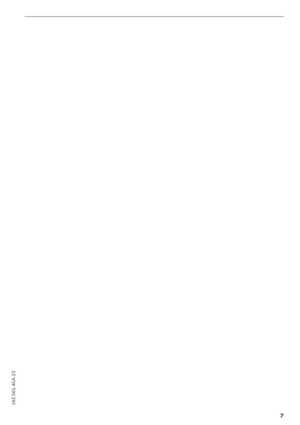 9
9 10
10 11
11 12
12 13
13 14
14 15
15 16
16 17
17 18
18 19
19 20
20 21
21 22
22 23
23 24
24 25
25 26
26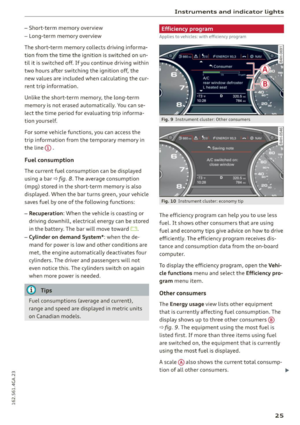 27
27 28
28 29
29 30
30 31
31 32
32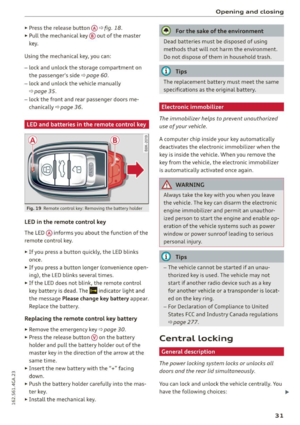 33
33 34
34 35
35 36
36 37
37 38
38 39
39 40
40 41
41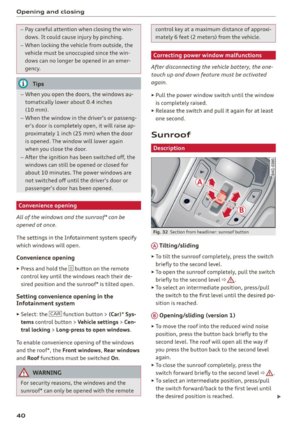 42
42 43
43 44
44 45
45 46
46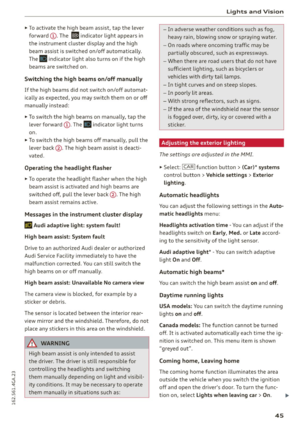 47
47 48
48 49
49 50
50 51
51 52
52 53
53 54
54 55
55 56
56 57
57 58
58 59
59 60
60 61
61 62
62 63
63 64
64 65
65 66
66 67
67 68
68 69
69 70
70 71
71 72
72 73
73 74
74 75
75 76
76 77
77 78
78 79
79 80
80 81
81 82
82 83
83 84
84 85
85 86
86 87
87 88
88 89
89 90
90 91
91 92
92 93
93 94
94 95
95 96
96 97
97 98
98 99
99 100
100 101
101 102
102 103
103 104
104 105
105 106
106 107
107 108
108 109
109 110
110 111
111 112
112 113
113 114
114 115
115 116
116 117
117 118
118 119
119 120
120 121
121 122
122 123
123 124
124 125
125 126
126 127
127 128
128 129
129 130
130 131
131 132
132 133
133 134
134 135
135 136
136 137
137 138
138 139
139 140
140 141
141 142
142 143
143 144
144 145
145 146
146 147
147 148
148 149
149 150
150 151
151 152
152 153
153 154
154 155
155 156
156 157
157 158
158 159
159 160
160 161
161 162
162 163
163 164
164 165
165 166
166 167
167 168
168 169
169 170
170 171
171 172
172 173
173 174
174 175
175 176
176 177
177 178
178 179
179 180
180 181
181 182
182 183
183 184
184 185
185 186
186 187
187 188
188 189
189 190
190 191
191 192
192 193
193 194
194 195
195 196
196 197
197 198
198 199
199 200
200 201
201 202
202 203
203 204
204 205
205 206
206 207
207 208
208 209
209 210
210 211
211 212
212 213
213 214
214 215
215 216
216 217
217 218
218 219
219 220
220 221
221 222
222 223
223 224
224 225
225 226
226 227
227 228
228 229
229 230
230 231
231 232
232 233
233 234
234 235
235 236
236 237
237 238
238 239
239 240
240 241
241 242
242 243
243 244
244 245
245 246
246 247
247 248
248 249
249 250
250 251
251 252
252 253
253 254
254 255
255 256
256 257
257 258
258 259
259 260
260 261
261 262
262 263
263 264
264 265
265 266
266 267
267 268
268 269
269 270
270 271
271 272
272 273
273 274
274 275
275 276
276 277
277 278
278 279
279 280
280 281
281 282
282 283
283 284
284 285
285 286
286 287
287 288
288 289
289 290
290 291
291 292
292 293
293






